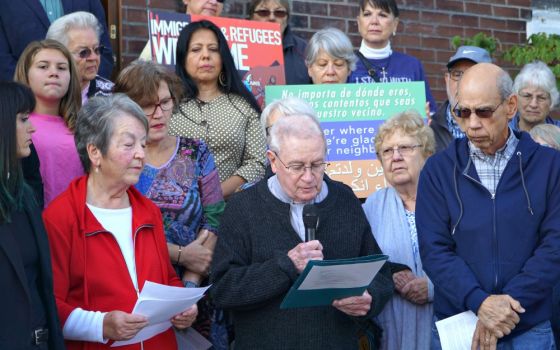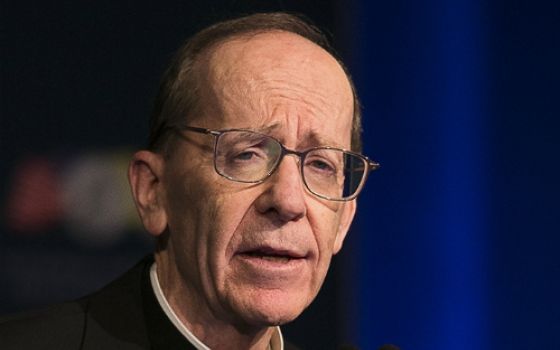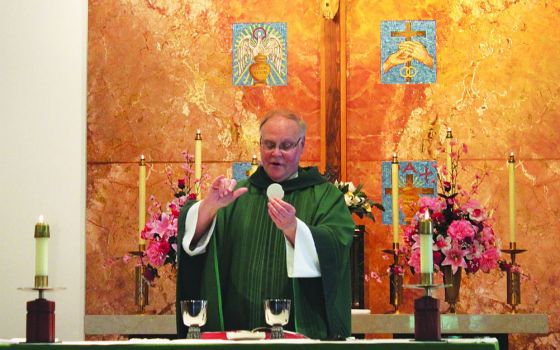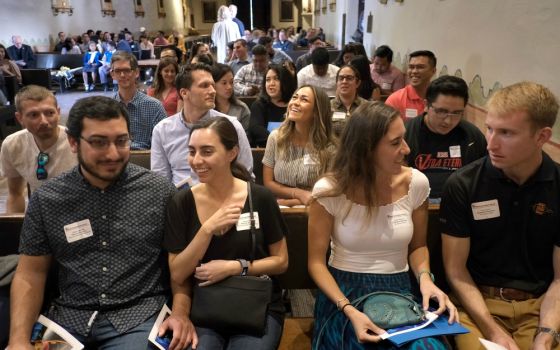Energy use has electrified a swell of Catholics this summer in the four-county Monterey, Calif., diocese, where new initiatives inspired by Pope Francis’ environmental encyclical seek not only wholesale changes in their parishes but the community as a whole.
The effort is the result of a partnership between the diocese and the Romero Institute, a non-profit law and policy center focused on social justice issues. Through its Green Power program, the institute is working with faith communities along California’s central coast to set up “Green Power” teams to help them reduce electricity consumption and move toward the use of renewable energy in their church infrastructure. Part of that includes exploration of installing rooftop solar arrays where possible.
A first step in the new project came July 17 at Resurrection Church in Aptos, where Green Power and the Monterey diocese held a training session for 100 Catholics representing parishes through the diocese, which includes Santa Cruz, Monterey, San Benito and San Luis Obispo counties.
In a letter a month earlier to his priests and deacons introducing the new environmental push, Monterey Bishop Richard Garcia said the program ushers in “a new era of green community culture where our parishes become a guiding light in sustainable, ecofriendly living.”
“Lowering carbon levels is now imperative to protect the earth,” he wrote.
Garcia said that in his encyclical “Laudato Si’, on Care for Our Common Home,” Francis acknowledged the reality of human-caused climate change, and that “all life systems are now threatened,” including the poor. Because of that, climate change is an issue of justice, said the bishop.
“This is our common home. We, as people of God and in Jesus’s name, must protect it from ourselves,” Garcia wrote.
In a follow-up letter Aug. 24, Garcia described the climate change initiative as “off to a strong start.” He also introduced a second dimension of the campaign in the diocese officially endorsing the adoption of Community Choice Energy (CCE) in the Monterey Bay region.
CCE, which became law in California in 2002, allows cities and counties a say in their energy provider by selecting the source and price of the electricity. The Monterey Bay area has been prepping to implement the program for three years, said the bishop. He encouraged priests and deacons to “mobilize Catholic support” in their parishes, in the form of advocacy and petition drives, for its passage. City councils and boards of supervisors are expected to be voting through the end of October on whether to join a CCE.
Forming a CCE would cut fossil fuel reliance in half within a year through expanded use of solar and wind energy, with those sources providing as much as 85 percent of electricity generation within 10 years, Garcia said in the letter. Economically, any profits from surplus electricity sold would return to the community through lower energy bills or construction of solar fields and wind farms -- and with them, local jobs. Garcia noted that Sonoma County, a region roughly half the size of the potential Monterey Bay Community Power, has seen $35 million in surpluses in two years.
Earlier in his letter, Garcia said that through Laudato Si’ the pope again “made clear that Earth’s changing climate threatens us all, especially the poor, and is due to human activity. He asked us to move away from fossil fuels and towards cleaner sources of energy, like wind and solar, and to consume less -- so that our earth and all living beings may flourish.”
In Laudato Si’ paragraph 165, Francis said, “We know that technology based on the use of highly polluting fossil fuels -- especially coal, but also oil and, to a lesser degree, gas -- needs to be progressively replaced without delay.”
More: "Chicago parishes look to do more with less through energy efficiency" (June 28, 2016)
Scientists say holding global warming at or below 1.5 degrees Celsius (2.7 Fahrenheit) -- a target included in the Paris Agreement reached by 195 nations last December -- would require eliminating 80 percent the world’s carbon and other greenhouse gas emissions by 2030 and 100 percent by 2050. So far, average global temperatures have warmed roughly 1 degree above pre-industrial levels.
Meeting the ambitious 1.5 degrees goal, though, will require dramatic action and the development of technologies not currently existing. Intergovernmental Panel on Climate Change estimates indicate that targeting a 66-percent chance of meeting the 1.5 goal would mean global carbon budgets would be exhausted in little more than five years.
The pope stressed the urgency of the climate issue last November ahead of the Paris climate change summit, saying “We are at the limit. We are at the limit of a suicide, to say a strong word.”
As David Roberts outlined earlier this month at Vox.com, electricity offers perhaps the best route to full decarbonization of the energy sector, and with it to addressing climate change. But the benefits of an “electrify everything” strategy also extend to public health -- less energy from combustion means less pollutants in the air from fossil-fueled cars and power plants.
Spearheading the Monterey diocese’s energy efforts is the Family Life and Social Concerns office, led by Deacon Warren Hoy. The deacon said the diocese is excited by the new initiative and partnership with the Romero Institute, which is on the steering committee of the Global Catholic Climate Movement.
“We’re happy to see the parishes moving toward solar power to provide clean energy for themselves and perhaps others in need,” Hoy said.
The Tani family, parishioners at Holy Cross Church in Santa Cruz, were among those attending the mid-July Green Power training program. For the last four years, Julie Tani has taught students at Good Shepherd Catholic School, in Santa Cruz, about the intrinsic value of living things through the school’s “Life Lab” gardens.
“I want them to know that it's our job to take care of God's creation. We plant seeds, tend the garden, harvest produce, prepare food, eat, and compost the left-overs. We observe how we and the natural world are interconnected,” she said.
Her husband, Hiro, said he’s happy to see the diocese partner with the Romero Institute and hopes the project takes off, especially in identifying alternative sources of energy for its many buildings. He previously wrote the diocese expressing his desire to see it go solar. While that will be explored through this new endeavor, it’s unclear if another of his requests may materialize.
“I said that priests and nuns should be driving electric cars or hybrids,” he said.
[Marie Venner is chair of the National Academies’ Transportation Research Board subcommittee on Climate Change, Energy, and Sustainability and former co-chair of the Risk and Resilience Planning and Analysis subcommittee. She is also on the Steering Committee of the Global Catholic Climate Movement.]
Editor's note: This story is part of a new joint project of two NCR blogs, "Eco Catholic" and "The Field Hospital," looking at parish- and grassroots-level efforts by Catholics to live out Pope Francis' encyclical, "Laudato Si', on Care for Our Common Home." Follow both The Field Hospital and Eco Catholic for future reports.
Want more stories from Eco Catholic? We can send you an email alert once a week with the latest. Just go to this page and follow directions: Email alert sign-up.



